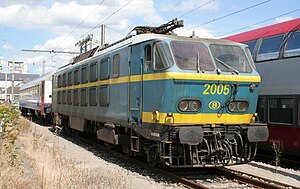SNCB Class 20

2005 stabled at Luxembourg, 2007-08-13.
|
|||||||||||||||||||||||||
|
|||||||||||||||||||||||||
|
|||||||||||||||||||||||||
|
|||||||||||||||||||||||||
|
|||||||||||||||||||||||||
| Type and origin | |
|---|---|
| Power type | Electric |
| Builder | BN/ACEC |
| Build date | 1975–1977 |
| Total produced | 25 |
| Specifications | |
|---|---|
| UIC class | Co'Co' |
| Gauge | 1,435 mm (4 ft 8 1⁄2 in) |
| Driver dia. | 1,250 mm (49 in) |
| Length | 19.5 m (64 ft 0 in) |
| Loco weight | 110 t |
| Electric system(s) | 3000 V DC |
| Current collection | Pantograph |
| Performance figures | |
|---|---|
| Maximum speed | 160 km/h (99 mph) |
| Power output | 5150 Kw (7004 HP) Continuous, 5400 Kw (7344 HP) One Hour |
| Tractive effort | 314 kN (71,000 lbf) |
| Career | |
|---|---|
| Operators | SNCB/NMBS |
| Class | 20 |
| Number in class | 25 |
| Numbers | 2001–2025 |
| Nicknames | Queen of the Rails |
| Delivered | 1975-1978 |
| First run | September 1975 |
| Last run | December 2013 |
| Retired | 31 December 2013 |
| Current owner | SNCB |
| Disposition | 2020 scrapped after collision in 1991, 2012 scrapped in 2013. The rest were scrapped by the end of 2015. |
Class 20 is a class of electric locomotives formerly operated by SNCB, the national railway of Belgium.
Prior to the introduction of the Class 13, Class 20 was the most powerful NMBS/SNCB electric locomotive class in Belgium, a distinction it held for 30 years. They commonly worked on Brussels - Luxembourg services, later sharing passenger duties with the CFL Class 3000s. Unusually for SNCB they are Co-Co locomotives.
The SNCB Class 20 was based on plans for a 7000-horsepower four system electric locomotive drawn up by SNCB in 1968. The four system requirement was later dropped and 15 of these locomotives, equipped to run only on 3000 volts DC, were ordered from BN in 1973. Production started in 1975 and an order for 10 more was placed with BN soon after the first one was delivered. Production ended in 1978.
There were no prototypes built and given that this locomotive was on the cutting edge technology in its day, that turned out to be a mistake. After a short time they started having problems and failures in service and it took SNCB over five years to sort them all out. The first problem area was the ACEC Type G transmission. They all had to be rebuilt with stronger gears and that fix solved the problem. Oddly enough, the Type G transmission was the only part of the Class 20 that had been fully tested before entering service. The reason it caused problems in service was that it was tested on locomotive 124.001/2401/2383 (all the same one) which had four much less powerful traction motors compared to the six much larger motors of the Class 20. The other major problem was the thyristor control system for the traction motors. Some major modifications were made over time and reliability greatly improved. Even after these changes they had to be driven gently for the rest of their service lives. They could still run at their top speed of 160 KmH (99 MPH) but maximum acceleration was forbidden.
The SNCB Class 20 had three 'firsts' to its credit. It was the first pure direct current locomotive in the world to make 7,000 HP or anything close. It was also the first and only locomotive to use the ACEC Type G transmission. Finally, it was the first pure DC electric locomotive in the world to have thyristor control. Although the Class 20 had no predecessor it became the prototype for classes 11, 12, 21 and 27 which were much more reliable from the start based on what was learned from the Class 20's problems. Although it was not a technological first, the Class 20 was also the SNCB's first (and so far only) all service electric locomotive with a Co-Co wheel arrangement, a feature that helped it to pull heavy freight trains easily through the Ardennes in spite of its 160 KmH gearing.
...
Wikipedia
